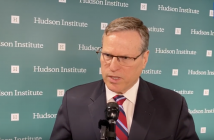Read the Report – With more than 11 million veterans in the workforce and approximately 175,000 service members discharged each year from active service, the overall economic performance of veterans is a critical component of veteran reintegration, wellness, and success. Indeed, the successful transition of veterans after service is imperative not just for their own economic well-being but for the viability of the All-Volunteer Force, to the extent that this success influences the propensity of future generations to serve in the military.
It is clear, examining veteran wellness holistically, that gainful employment can provide the foundation for successful transition, offering compensation, a social network, and geographic stability. While prior efforts to improve the transition process have focused on unemployment rates and hiring, this study looked beyond initial hiring data to examine the behavior of veterans in the workforce, including retention and performance, as well as corporate perceptions of how veterans perform once hired. This study found that veterans are likely to leave their first job out of service relatively quickly, but their reasons differ widely. Most leave jobs for greener pastures – higher salaries, more responsibility, or a better fit – in positive ways that mirror non-veterans. A minority leave jobs for negative reasons, including those who are terminated, a bad match with their manager, or otherwise unhappy. However, low initial retention rates for veterans do not necessarily indicate a problem so much as reflect a general trend in the workforce, seen also in similar populations such as new college graduates or new managers. When movement of veterans between jobs occurs for good reasons, it can be viewed as positive indicator and over time helps veterans find their best fit within the workforce. Notwithstanding all that, there are indications that a significant minority of veterans still struggle to find their place in the civilian sector, with many facing underemployment as they transition from service and move between jobs or positions. A better understanding of veteran turnover will allow public-sector efforts to be more precisely targeted at the population segments that struggle the most during transition. Likewise, a more nuanced understanding of employment and retention will improve corporate execution of veteran hiring initiatives.
This study highlighted a number of dynamics surrounding veteran economic performance, with the primary findings and recommendations as follows:
- Data collection regarding veteran retention and economic performance ranges from fair to nonexistent across the companies interviewed. This partly results from uneven government requirements to collect data that apply mostly to government contractors (rather than all firms), and only to certain classes of veterans. Improving data collection efforts by both private- and public-sector stakeholders to better track and understand veteran employment outcomes may provide more insight into veteran economic performance and also help companies achieve better outcomes with respect to veteran employment and corporate performance.
- Incentivizing employers to value and measure veteran fit and performance rather than focusing on hiring metrics alone could improve retention, requiring a renewed look at how veteran hiring initiatives evaluate success and promoting programs such as mentorship and affinity groups.
- Veteran retention rates are comparable to those of other groups in the workforce, making the high first-year turnover rate of veterans a phenomenon not necessarily related to veteran status.
- Most veterans will leave their first job after service within one year. However, most of these veterans leave their jobs for positive reasons, such as a move for more money, more responsibility, or a better location. A minority of veterans leave jobs for negative reasons, such as clashes with management or performance issues. However, there are no indications that veterans leave for negative reasons relating to their veteran status.
- There appears to be lower turnover among veterans once they have found the correct fit, indicating that securing a role in a desired field is one of the strongest factors increasing retention of veterans.
- While most veterans transition and perform well economically, a significant minority continues to struggle, facing issues such as underemployment and difficulty working in a non-military environment.
- The current transition programs are well structured and aim to convey the most critical skills and information, but they vary by location, could use more robust oversight of their implementation and effectiveness, and could be extended and broadened to provide more depth and individualization to the course.
- Financial literacy is an area that could be easily integrated into mandatory training and is essential to successful transition, with a financial safety net providing a greater amount of time to secure initial employment as well as preventing issues such as homelessness.
- There is evidence to support the economic value of veteran employment. Studies have documented its economic value to society, as well as the greater aggregate profitability of firms that hire veterans. CNAS survey results corroborated these studies, finding that managers perceive veterans as high-performing employees who add value to their workforce.




